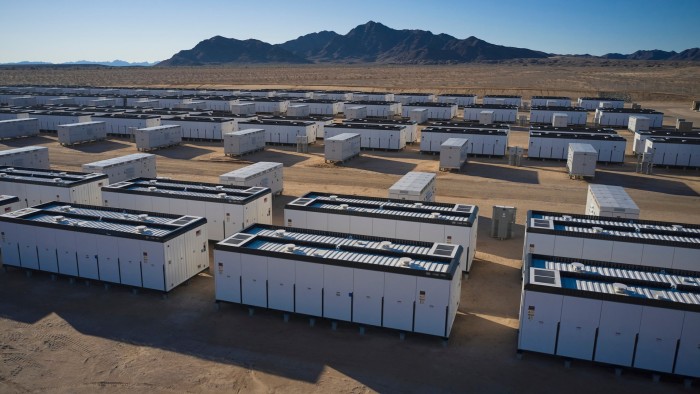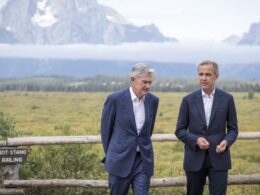Welcome to Energy Source, coming to you from New York.
The US economy contracted by an annualised 0.3 per cent over the first quarter, as companies rushed to import goods ahead of Donald Trump’s sweeping tariffs.
Gloomy economic data and reports that Saudi Arabia is unwilling to prop up the oil market with further supply cuts caused crude prices to slump on Wednesday.
Brent crude, the international benchmark, settled 1.7 per cent lower at $63.12 a barrel while US West Texas Intermediate fell 3.6 per cent to close at $58.21. In April, Brent declined 15 per cent and WTI 18 per cent, the largest monthly declines in almost three and a half years.
Fears over a weakening economy and trade policy uncertainty have also rocked US companies. My colleague Martha Muir reported the Trump administration’s cuts to the clean energy industry have caused 20,000 job losses in the US and threatened almost $70bn in project investments.
Trump’s tariffs have threatened the renewable energy industry, especially the battery storage sector, which relies heavily on Chinese imports.
Today we take a closer look at the US energy storage industry’s $100bn pledge to manufacture and buy American-made batteries, which it expects to meet 100 per cent of domestic energy storage demand by 2030. But some industry experts say five years and $100bn is not enough time or money for a sector that faces an existential threat from tariffs and policy uncertainty.
Programming note: We’re taking a short break for the May 5 UK bank holiday. Energy Source will be back in your inbox next Thursday.
Is $100bn enough to power the US battery boom?
Donald Trump’s trade war and efforts to limit renewable energy development pose a threat to the US battery boom, which has been crucial to helping meet surging electricity demand from artificial intelligence.
The US has seen an explosion in battery deployment on its electricity grid, thanks to federal tax credits in the Inflation Reduction Act. The energy storage industry, which is dependent on imports from China, has helped meet power demand by storing renewable generation during times of excess and discharging it when supply drops.
Trump’s “reciprocal” tariffs and calls to repeal the IRA tax credits threaten to put an end to the industry’s rapid expansion. BloombergNEF estimated the president’s China tariffs will impose a 156 per cent duty on energy storage imports and “devastate” the sector.
On Tuesday, American Clean Power, the clean energy industry trade group, announced a $100bn commitment on behalf of the energy storage industry to manufacture and buy US-made batteries with the aim of meeting 100 per cent of domestic energy storage demand by 2030.
The announcement includes about $10bn to $15bn of previously announced active investments as well as an additional $85bn to $90bn of new commitments from manufacturers and buyers of grid batteries. The ACP said the investment is contingent on “stable tax and trade policy”.
But the endeavour will be hard to achieve as US battery makers — still in their infancy — struggle to compete with China, which produces nearly 90 per cent of the world’s batteries for energy storage systems at a fraction of the cost.
Wood Mackenzie estimated only 30 per cent to 40 per cent of US domestic energy storage demand will be met by American-made batteries by 2030.
Yayoi Sekine, BloombergNEF’s head of energy storage, said: “The US doesn’t currently have enough battery cell manufacturing capacity to meet domestic demand, and isn’t expected to ramp up enough even with existing facilities and plans in the works.”
The industry faces fierce competition from China, which is much further along in its battery manufacturing process and has years of experience perfecting and scaling the technology. Five years may not be enough time to compete with China.
Robert Greskowiak, chief commercial officer at energy storage developer Lightshift Energy, said the cost of US-made battery components is more expensive than international products. He added 100 per cent of the battery cells and containers that Lightshift purchased in 2024 were sourced from China.
“The reality, though, is domestic [battery] manufacturing in the US today is very limited in supply,” Greskowiak said. “These supply chains just take time to set up and so that’s been in progress, but we’re not there yet.”
US battery makers have faced delays and cancellations because of tough market conditions and the lack of competitiveness with China. Kore Power and Freyr Battery cancelled battery plant projects this year in Arizona and Georgia, respectively.
Alexei Andreev, co-founder of venture capital firm Autotech Ventures, said it would require “enormous heavy lifting” for the US to start manufacturing its own battery cells because the country would have to start from “scratch”.
“There is a lot of engineering knowhow and so it’s one thing to produce a few cells here and there,” Andreev said. “It’s a completely different story to have high-yielding low-cost, very repeatable manufacturing flow.”
Attempts from Chinese battery makers to localise US production, however, have become a political flashpoint in US-China relations. Gotion, a Chinese battery company that was scheduled to build a $2.4bn factory in Michigan, has sued the local government for allegedly halting the development of the plant.
American Battery Factory, which aimed to build the country’s largest battery gigafactory in Arizona, had delayed its launch and recently announced it would partner with Chinese company KAN Battery to develop a pilot line of battery cells.
John Kem, the president of American Battery Factory, said at the time of the announcement that the US was “10 years behind the leaders of battery cell production”. He added that in order to develop a domestic supply chain, “we must work together with the best in the world”.
Some analysts and industry experts have also said $100bn may not be enough to jump-start the industry in the US.
Mujeeb Ijaz, founder and chief executive of battery manufacturer Our Next Energy, which has invested $1.6bn to build a factory in Michigan, said establishing domestic battery manufacturing is going to “take a lot more than $100bn”.
Andrew Waranch, chief executive of battery energy storage system Spearmint Energy, agreed.
“I don’t think that $100bn is enough,” he said. “The $100bn doesn’t go far if you’ve got to build all parts of the supply chain at once.”
China committed about $100bn in energy storage and electric vehicle battery investments in the past two years, compared to only $44bn that had been announced over the past two years in the US, according to Wood Mackenzie.
While tariffs may help level the pricing between domestic products and imports, many US manufacturers import raw materials. Higher prices are also leading developers to rethink their balance sheets and building plans.
Waranch said the tariffs, if implemented, will raise prices and cause the company to downsize their plans to build battery storage systems. More than 90 per cent of the batteries his company used are made outside the US.
“The tariffs, at least when it comes to batteries and renewable energy, are rather harmful,” he added.
The American Clean Power Association said the plan for US-made batteries to meet 100 per cent of domestic energy storage is feasible so long as it is supported by “stable tax and trade policy” and “streamlined” permitting.
A person familiar with industry efforts around manufacturing and deployment said the organisation’s goal is also contingent on the industry’s removal from “reciprocal” tariffs.
Political support is crucial for scaling the industry. Projects are contingent on federal tax credits in the IRA, which Trump vowed to “terminate” on the campaign trail and is currently on the chopping block as Republicans draft a budget in Congress.
“Having money is great, but having long-term visibility, even midterm certainty about the tariff policies is even more important because you need to make massive deployments and massive irrevocable commitments,” Andreev said. “It’s an irrevocable commitment to build a new industry from scratch.” (Alexandra White)
Job moves
-
Ukraine’s Naftogaz has appointed Serhiy Koretskyi as its chief executive.
-
Meridian Energy Group has named Mandy Simpson as its new chief financial officer.
-
Novonix tapped Michael O’Kronley as its chief executive.
Power Points
-
Equinor is considering suing the Trump administration after it halted construction of the Norwegian energy group’s $4.5bn wind farm.
-
India’s Prime Minister Narendra Modi is courting Latin America to secure the minerals its needs to meet its green energy targets.
-
Falling crude prices are expected to hit Big Oil’s earnings, marking the third consecutive 12-month period of falling profits after its pandemic-era gains.
Energy Source is written and edited by Jamie Smyth, Martha Muir, Alexandra White, Tom Wilson and Malcolm Moore, with support from the FT’s global team of reporters. Reach us at energy.source@ft.com and follow us on X at @FTEnergy. Catch up on past editions of the newsletter here.
Recommended newsletters for you
Moral Money — Our unmissable newsletter on socially responsible business, sustainable finance and more. Sign up here
The Climate Graphic: Explained — Understanding the most important climate data of the week. Sign up here
Source link









